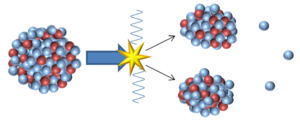Difference between revisions of "Nuclear Fission"
| Line 22: | Line 22: | ||
: If there is enough of an [[Unstable Isotope|unstable isotope]] in a [[material]] a single '''nuclear fission''' can trigger a [[Nuclear Chain Reaction|nuclear chain reaction]] in which the [[neutron]]s produced from the initial '''fission''' event can cause the '''fission''' of more than one other [[Unstable Isotope|unstable isotope]]. | : If there is enough of an [[Unstable Isotope|unstable isotope]] in a [[material]] a single '''nuclear fission''' can trigger a [[Nuclear Chain Reaction|nuclear chain reaction]] in which the [[neutron]]s produced from the initial '''fission''' event can cause the '''fission''' of more than one other [[Unstable Isotope|unstable isotope]]. | ||
: A [[Nuclear Fission|nuclear fission]] [[Nuclear Chain Reaction|chain reaction]] is used in both [[Nuclear Bomb|nuclear bombs]] and [[Nuclear Fission Reactor|nuclear reactors]] in [[Nuclear Power|nuclear power stations]]. | : A [[Nuclear Fission|nuclear fission]] [[Nuclear Chain Reaction|chain reaction]] is used in both [[Nuclear Bomb|nuclear bombs]] and [[Nuclear Fission Reactor|nuclear reactors]] in [[Nuclear Power|nuclear power stations]]. | ||
| + | |||
| + | ===References=== | ||
| + | ====AQA==== | ||
| + | |||
| + | :[https://www.amazon.co.uk/gp/product/1782945970/ref=as_li_tl?ie=UTF8&camp=1634&creative=6738&creativeASIN=1782945970&linkCode=as2&tag=nrjc-21&linkId=a120d24dcc7cc7a58192069a3aafc1d2 ''Nuclear fission, page 140, GCSE Physics; The Complete 9-1 Course for AQA, CGP, AQA ''] | ||
| + | :[https://www.amazon.co.uk/gp/product/178294558X/ref=as_li_tl?ie=UTF8&camp=1634&creative=6738&creativeASIN=178294558X&linkCode=as2&tag=nrjc-21&linkId=f0dfb66dafcb0c6e9449e7b1a4ae1ac337 ''Nuclear fission, page 49, GCSE Physics; The Revision Guide, CGP, AQA ''] | ||
| + | :[https://www.amazon.co.uk/gp/product/019835939X/ref=as_li_tl?ie=UTF8&camp=1634&creative=6738&creativeASIN=019835939X&linkCode=as2&tag=nrjc-21&linkId=57e96876985fc39b1a3d8a3e3dc238b6 ''Nuclear fission, pages 104-105, GCSE Physics; Third Edition, Oxford University Press, AQA\ ''] | ||
| + | :[https://www.amazon.co.uk/gp/product/1471851370/ref=as_li_tl?ie=UTF8&camp=1634&creative=6738&creativeASIN=1471851370&linkCode=as2&tag=nrjc-21&linkId=01c69b0ae058f809cf636033e6ba793e ''Nuclear fission, pages 106-7, GCSE Physics, Hodder, AQA ''] | ||
Revision as of 14:40, 10 November 2019
Key Stage 4
Meaning

An model of nuclear fission.
Nuclear fission is a process in which a large unstable nucleus splits into two more stable nuclei.
About Nuclear Fission
- Nuclear fission occurs when a massive nucleus is so unstable that it splits in two.
- During nuclear fission neutrons are also emitted.
- Nuclear fission transfers energy from the nuclear potential energy store into the thermal energy store of the material and the surroundings.
- In a nuclear fission reaction the products have less mass than the reactants as some of the mass is converted into energy in the process due to the Mass-Energy Equivalence.
- Nuclear fission can be induced in a material by bombarding massive nuclei with neutrons. If a neutron is captured by the nucleus it becomes so unstable that it splits in two.
- The neutrons used to induce fission must have a low energy to be captured by a nucleus otherwise the neutrons will just pass straight through without being captured. Neutrons with the right amount of energy to be captured are called thermal neutrons because they have a similar energy to molecules in the air at room temperature.
| A model showing a possible mechanism for induced nuclear fission resulting from the capture of a thermal neutron.
\({}_{92}^{235}U + {}_{0}^{1}n \rightarrow {}_{92}^{236}U \rightarrow {}_{36}^{85}Kr + {}_{56}^{148}Ba + 3{}_{0}^{1}n\) |
- If there is enough of an unstable isotope in a material a single nuclear fission can trigger a nuclear chain reaction in which the neutrons produced from the initial fission event can cause the fission of more than one other unstable isotope.
- A nuclear fission chain reaction is used in both nuclear bombs and nuclear reactors in nuclear power stations.
